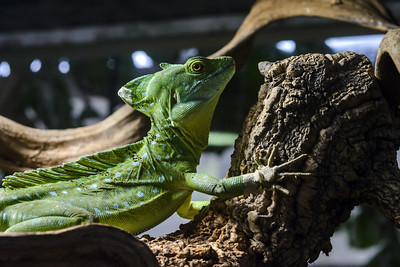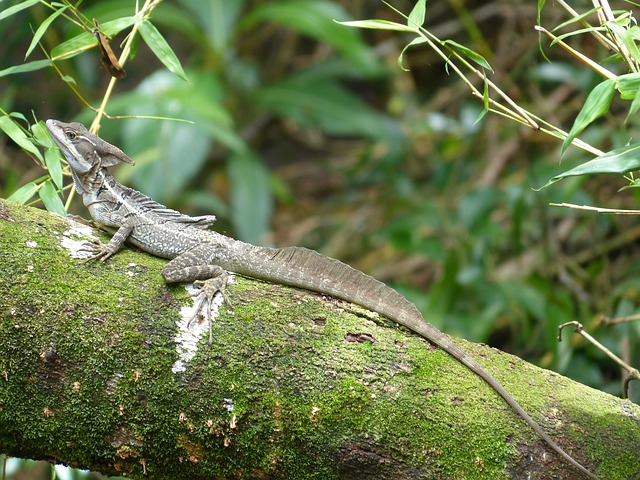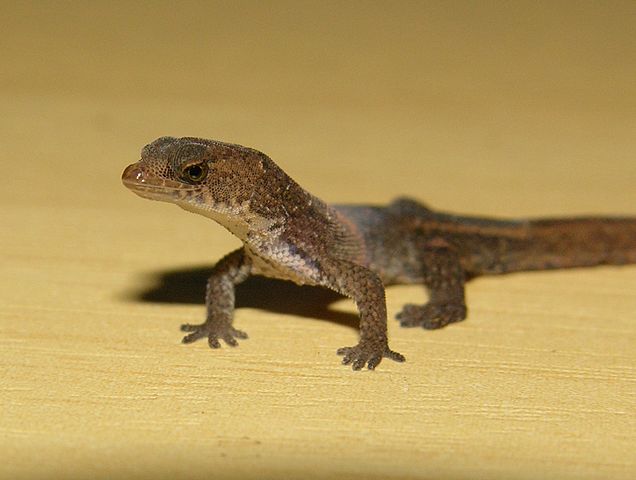The Masters of Walking on Water
Basilisk lizards (genus Basiliscus) are nicknamed Jesus Christ lizards, and I believe you all guess why - they can run on water!
It's not to show-off - it's a runaway mechanism. When a bazilisk gets frightened by a predator near water (e.g. a snake), it'll start running with a speed of up to 1.5 m (5 ft) per second, and can go for a distance of up to 4.5 m (15 ft) before it starts to sink. Check out the common basilisk (Basiliscus basiliscus) escaping a snake in the video!
Shi-Tong Tonia Hsieh and her advisor George Lauder at the Department of Organismic and Evolutionary Biology at Harvard University figured out how it is possible for the plumed basilisk (Basiliscus plumifrons) to 'imitate Jesus'.
The lizard's stride consists of three phases: (1) the slap, (2) the stroke and (3) the recovery.
During the slap phase, the foot moves vertically downward - it slaps the water. In the second part, the foot moves backward, and in the third it moves up, out of the water, and then the cycle repeats itself.
As the lizard slaps down its foot, it creates a pocket of air around it, generating enough force to stay on the surface of the water during the next phase (2), when the lizard moves forward.
There's one more thing the lizard must do in order to stay upright - create lateral reaction forces off to the sides. When the lizard moves to the right, it'll need to create a force that will push it back to the left. If it stops moving, it'll sink immediately.
Therefore, it first pushes outward as it falls toward the supporting limb, then pulls toward its body as its center of mass moves away from the foot. This way the lizard creates forces that promote its stability during the escape.
What happens if they sink? They're agile swimmers, and can hold their breath for up to 30 minutes!
The lizard even inspired scientists at the NanoRobotics Laboratory of Carnegie Mellon University to build a robot capable of running on water.
This ability seems to be size-dependent, at least in the common basilisk (Basiliscus basiliscus), meaning that juveniles are capable of running on the surface more efficiently than adults. This makes the population dynamics of the species really interesting, as these physical constraints possibly lead to intra-specific resource partitioning - juveniles and adults live in different habitats because adults have higher mortality near water, so they move away from it. As a result, the basilisk lizards can live in high population densities that are so typical for them.
The Jesus Christ lizard isn't the only herp capable of walking on water. While this species must move in order to stay above the surface, there's another one that can simply stand on water without the slightest move.
This is the Brazilian pygmy gecko (Chatogekko amazonicus), a leaf-litter gecko found in the Amazon Basin, searching the litter for springtails. It's really small, only between 2-4 cm (0.8-1.6 in) long, or, as herpetologists like to say, its snout-vent length is up to 2.4 cm (0.94 in). The bottom line is - it's tiny, so it's pretty good at hiding from predators and it doesn't have to compete for resources with other reptiles too much.
Watch the gecko stand on water.
It does, however, have other enemies. Enemies, that are not actually alive.
It's so small that it could drown in a raindrop. The little Amazonian reptile evolved, just like other geckos, a hydrophobic (water-repelling) skin, which, in combination with its minute size allows it not only to run on water, but also to stand still on its surface without breaking the surface tension. When it jumps into a puddle, it does not sink. Instead, it floats peacefully without a problem.
Geckos evolved their hydrophobic skin possibly to avoid fungal and bacterial infections, since fungi and bacteria love wet surfaces, and to keep clean in general, since water often includes various other contaminants as well.
Chatogekko amazonicus was previously named Coleodactylus amazonicus, but phylogenetic analyses showed that the species is very deeply diverged from other Coleodactylus species. It is now the sole member of its genus.
These reptiles truly mastered the art of walking on water in a way that even Jesus Christ could envy.

Photo credit: hape662
| Common name: | Plumed or green basilisk |
| Scientific name: | Basiliscus plumifrons |
| Phylum: | Chordata |
| Class: | Reptilia |
| Order: | Squamata |
| Family: | Corytophanidae |
| IUCN status: | Least Concern |
| Population trend: | Stable |
| Scientific reading: |

Photo credit: Katrin Schulz
| Common name: | Common basilisk |
| Scientific name: | Basiliscus basiliscus |
| Phylum: | Chordata |
| Class: | Reptilia |
| Order: | Squamata |
| Family: | Corytophanidae |
| IUCN status: | Least concern |
| Population trend: | Stable |
| Scientific reading: |

Photo credit: William Magnusson
| Common name: | Brazilian pygmy gecko |
| Scientific name: | Chatogekko amazonicus |
| Phylum: | Chordata |
| Class: | Reptilia |
| Order: | Squamata |
| Family: | Sphaerodactylidae |
| IUCN status: | Least concern |
| Population trend: | Stable |
| Scientific reading: |